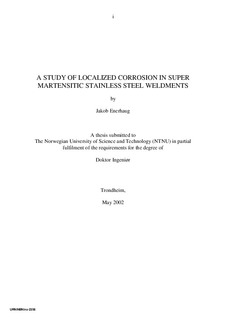| dc.description.abstract | This doctoral thesis is concerned with pitting corrosion in super martensitic stainless steel (SMSS) weldments in slightly sour service. Thee main objective with the present thesis has been to find out why pitting corrosion occurs in the heat affected zone (HAZ) at ambient rather than at elevated temperatures and how the corrosion mechanism depends on the welding process.
The thesis is divided into six parts. Part I gives a general introduction to martensitic stainless steels, focusing on the metallurgical and corrosion properties.
Part II is concerned with the conditions for initiating of pitting corrosion in two SMSS weldments. Optical microscopy in combination with sputtered neutral mass spectrometry has been used to examine the conditions, and it is shown that the corrosion resistance depends mainly on the nature of the surface oxide and less on the underlying microstructure. In the absence of H2S the initiation is associated with spalling of the iron-enriched chromium oxide within a narrow region approximately 6mm from the fusion boundary, where the contaminated oxide layer is thinnest. As H2S is introduced, the region close to the fusion boundary become susceptible to localised corrosion because of the more extensive metal oxidation. Thus, the high temperature oxidation and iron oxide scale formation accompanying the welding operation appears to be the main factor affecting the pitting corrosion initiation in SMSS weldments.
In Part III, a comparative study of the dissolution and repassivation behaviour of a Fe-12.3Cr-6.5Ni-2.6Mo SMSS alloy and other stainless grades has been carried out. The SMSS alloy is characterised by means of the so-called “artificial pit technique”, and a diffusion model has been developed and employed for calculation of the pit surface concentration of dissolved species during the potential step experiments. For concentrations close to the saturation level, the dissolution kinetics are adequately described by a Tafel slope of approximately 57mV/dec and a current density of 0.5mA/cm2 at –300mV SCE. On the other hand, repassivation of the active pit surface occurs when the concentration of the dissolved species drops below 30% of the saturation value. Based on a comparison with relevant literature data it is concluded that the observed response of the SMSS to localised corrosion is similar to that reported for other high-alloyed steels. This result is to be expected if the dissolution and repassivation kinetics are controlled by the content of Cr, Ni and Mo in the parent material.
In Part IV, the specific effects of H2S on the pitting corrosion behaviour of a Fe-12.3Cr-6.5Ni-2.6Mo SMSS alloy have been examined by means of the “artificial pit technique”. Addition of a critical amount of H2S is found to hinder repassivation and accelerate active dissolution in the SMSS pit within the stability domain of the adsorbed sulphur. Above the redox potential of H2S/S, the effect of H2S is found to cease, whereby dissolution and repassivation kinetics similar to H2S-free solutions are observed. Activated pits show no signs of repassivation, not even at low surface concentration of dissolved species. It is concluded that the resistance to pitting corrosion depends both on the potential and the H2S concentration and the effect of H2S is most significant at low potentials.
Part V is concerned with the occurrence and appearance of pitting corrosion in SMSS girth welds in the presence of H2S. Galvanostatic and potentiodynamic measurements were carried out at ambient temperature and pressure, using both a deaerated solution and a 1mM H2S solution. In conjunction with this study, a descriptive pitting corrosion model is proposed to explain the effect of the root surface condition and the role of H2S. The oxidized pipe surface close to the fusion boundary is found to be extremely vulnerable to pitting corrosion in the presence of H2S, while the same zone appears to behave inert in the deaerated solution. In the latter case the oxidised surfaces were found to repassivate. In the H2S solution, localized corrosion occurred in the most oxidized region of the HAZ, about 0 to 3mm from the fusion boundary. Moreover, it was found that a modification of the as-welded root surface by grinding hindered any initiation of pitting corrosion in this region, again highlighting the important role which high temperature oxidation and oxide scale formation play in controlling the corrosion properties of SMSS weldments.
Finally, in Part VI of the thesis, the practical implications of the above findings for choice and development of relevant corrosion test procedures have been considered. A key issue here is the effect of pre-exposure on the corrosion resistance of SMSS weldments in the presence of H2S. Pre-exposures have been simulated in test solutions resembling the conditions in a flowline. It is shown that the quality (i.e. passivity) of SMSS root surfaces can be largely improved by the use of an appropriate pre-exposure procedure. It is therefore recommended that all samples in the future are pre-exposed to an H2S-free solution before they are subjected to actual corrosion testing in solutions containing H2S to avoid pitting corrosion in the oxidized part of HAZ. This is deemed to be important in order to achieve realistic results. | nb_NO |
